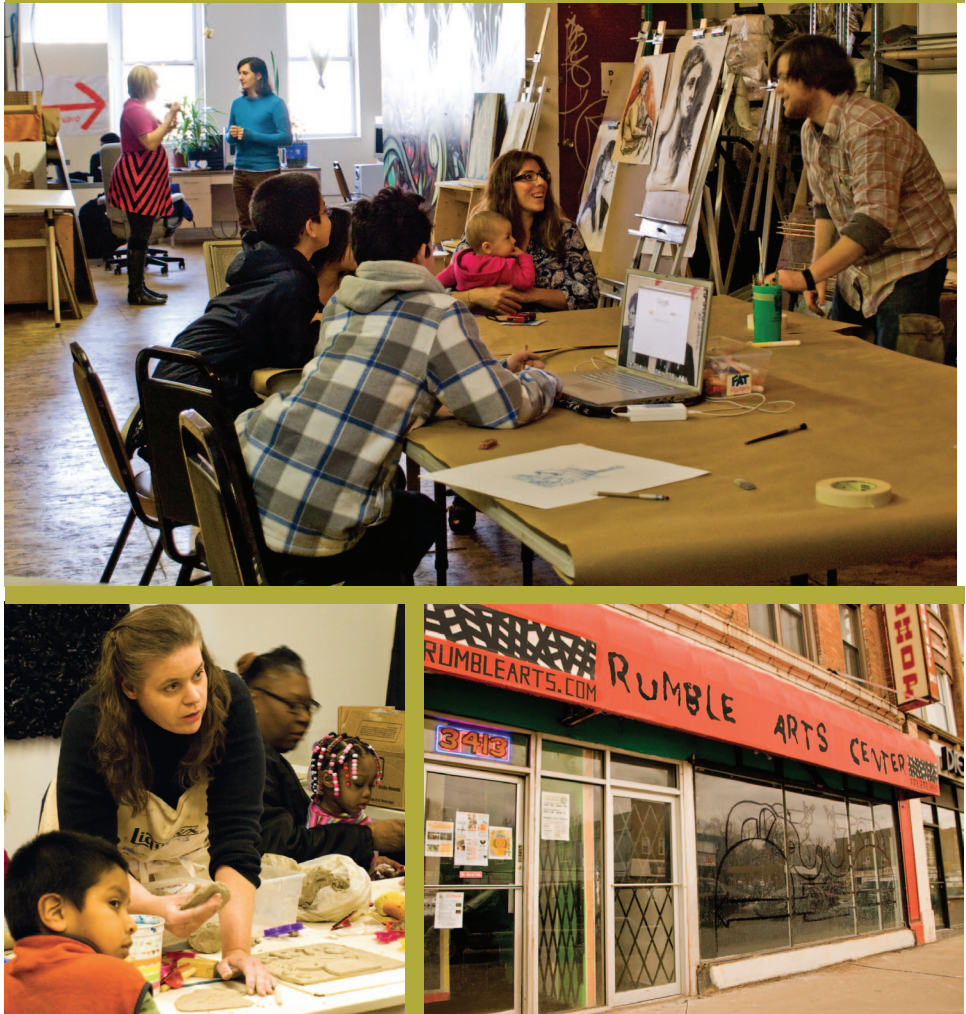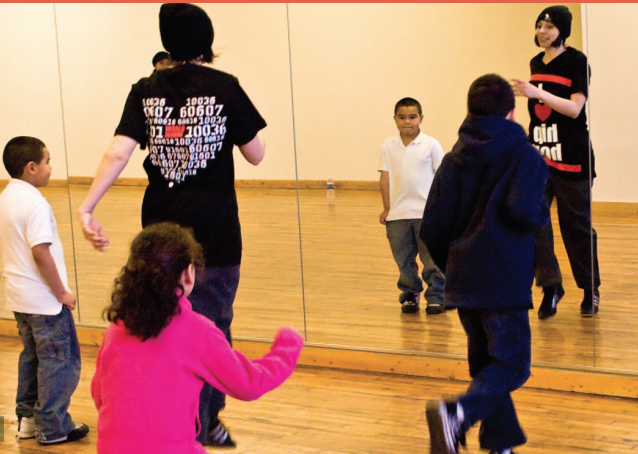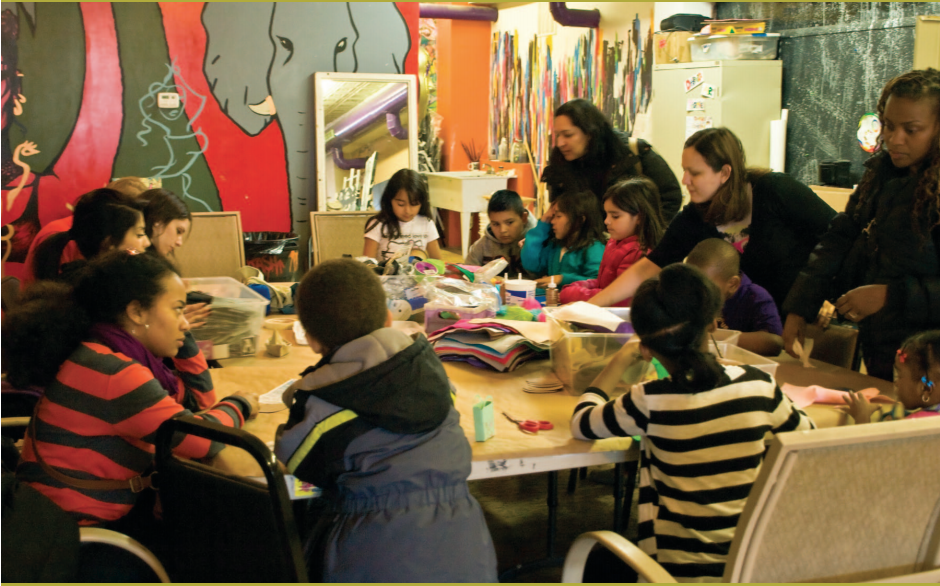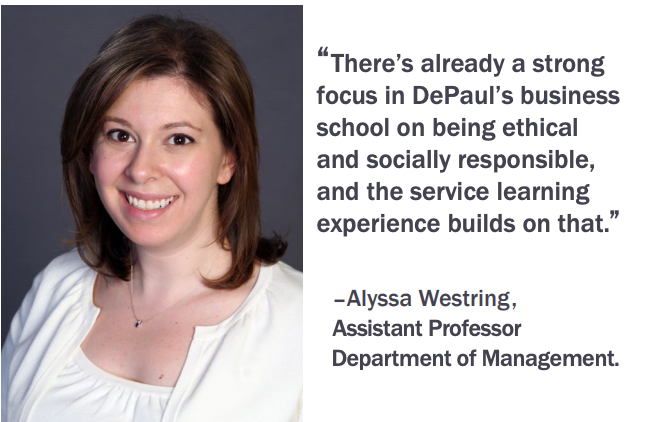
Students in Alyssa Westring’s course titled “Managing for
Effective and Ethical Organizational Behavior” engage in pro
bono activities for nonprofit clients that are trying to address
a range of organizational challenges. For ten weeks, students
consulted with nonprofit staff to understand the organizations
and then apply knowledge geared to improving their
effectiveness. “I definitely think there’s a place for service
learning in business school,” says Westring. “There’s already
a strong focus in DePaul’s business school on being ethical
and socially responsible, and the service learning experience
builds on that.”
The class reflects a dynamic that is impacting students as
well as the nonprofit and for-profit sectors. In 2007, Fortune
Magazine reported that the nonprofit sector comprises “more
than 10 percent of the total job market,” with “nonprofit
career growth surpassing the private sector in 46 of 50
states.” Consequently, it is increasingly common for people
in the business sector to find work within a growing nonprofit.
The trend suggests the need for greater business acumen:
nonprofits have been hit hard during this tough economic
period and need to find ways to make it even when resources
are scarce.
Westring’s MBA course opens the door for students to
learn business skills, get hands-on experience with an
organization, while applying their skills for the public good.
“In some cases, completing these projects went smoothly, in
other cases it was a struggle,” Westring says. “But even when
there’s struggle, that’s part of the learning.”
Jeff Howard, Assistant Director for Faculty Development at
the Steans Center, adds that Westring understood that “the
class was not only about students learning, but about their
opportunity to make a contribution to these organizations.”
Through this class, students begin to understand firsthand
how a small nonprofit organization operates.
Students learned that while many nonprofits may have scarce resources, they also find creative
ways to deliver much-needed services to
communities. The courses instructs them on
organizational behavior and then they apply
what they've learned in the classroom to
the field by providing specific insights about
partner organizations.
Prior to engaging directly with the
organizations, a staff member from Steans
Center partners spoke to the class. Students
were then divided among seven Chicago based nonprofit organizations: Passages
Alternative Living Programs, Inc., La Casa
Norte, Arts of Life, Telpochcalli Community
Education Project (TCEP), Rumble Arts Center,
Josephinum Catholic School, and Project
SYNCERE (Supporting Youths' Needs with
Core Engineering Research Experiments).
After gathering data from the organizations,
students presented their results to
organizations.
Rumble Arts Center 
“DePaul came to us, knowing we had done
internships with Steans, and said they had a
development team that could work with us,”
said Brook Woolf, Founder and Executive
Director of the Rumble Arts Center, an all-ages
multicultural community center in Chicago’s
Humboldt Park community. “We said yes:
our programs are pretty well-oiled, but we are
trying to get our financing and organization in
order.” The small organization is self-funded,
and has about 4,400 square
feet of rental space as well as
a gallery and a kitchen.
Woolf adds that students
and the organization worked
together in a way that made it
easier to address challenging
issues faced by Rumble Arts.
“Students asked some pretty
hard questions,” she said,
“and having them here made
us more comfortable to learn
something about them and why
they chose to work with us.”
Students created job descriptions for Rumble Arts that clarified specific
responsibilities. They also created a volunteer
application for those people who want to serve
with the organization.
Bree Johnson, program coordinator for the
Center, says that DePaul students did their
homework on the organization and came up
with a useful framework for the project. “The
information was organized in a way that maximized its usefulness,” she said. “They weren’t
in the dark about things and had specific questions. In the end, the resulting data reflected
what we knew were problems. Students assessed them clearly—even as outsiders. This
was helpful because, like many groups,” she
adds, “we sometimes fall victim to being too
busy and don’t always have time to reflect on
our needs and habits.”
Students used a variety of tools to assess
the organization’s needs, including interviews,
observation and surveys. “We learned that the
way staff schedules were aligned, employees
were only overlapping one day a week,” says
Lesley DeMaio, a student in Westring's course.
“There were times when staff members
thought another person was doing something
that they weren’t actually doing.” In the end,
students provided the organization with three
new job descriptions. The documents not only
specify what staff are responsible for, but
serve as a tool by which employees can be
evaluated.
The Arts of Life 
One key element of the students' projects was
forging relationships with an organization (and
its staff) in a short period of time. “Students
were super-approachable and appreciated the
time we took to talk with them,” says Denise
Fisher, executive director of The Arts for Life, a
small nonprofit that provides guidance, education and space to area adults with and without
disabilities as they produce their own art. That
eased our minds, and it was nice to get an
objective view of how we work.” “They were
very professional and considerate,” adds Ryan
Shuquem, Art Director for the organization.
“They had good ideas and definitely paid attention to what we had to say.” Students took
a close look at Shuquem’s position during the
process; one deliverable they suggested to the
group was the transfer of the intern/volunteer
process from the art director to the community
coordinator.
Shuquem says that students learned about
an all-too-common trait of life in small nonprofit organizations—“the nature of being constantly stretched.” In his job, Shuquem
coordinates collaborative projects with the
community, oversees gallery shows and exhibitions, and works with artists directly.
Collaboration is not just a theme in
his work, but in the work of students in
Westring’s class who formed for ten weeks.
“Everyone brought something different to the
table,” says Jason Kiper, who worked with The
Arts of Life. “That’s the big benefit of working
in a group. One person may have strong communications skills, while another has more
knowledge of information technology, and so
on.”
“Students in this class are basically
working together as consultants with
organizations,” adds Kiper. “It’s a challenging
job: how to get information from people
without making them appear as if they are
wrong. You have to realize that they know
more about their organization and what they
do than you ever will. You have to be careful
and positive while wondering how they do
their jobs." He says that people he worked
with at The Arts of Life were “very openminded.”
Kiper also echoed what many who have
participated in DePaul service learning
courses say. “I was excited to take this class.
This was learning that was going to take place
in the world of work. I was glad to get that
experience and jump right in.”
DePaul student Szalez Mayer
says that while students focused on
the job of providing a service to the
organization, he also had a chance
to appreciate what it does. “It was
really inspiring,” he says “The Center
gives people an avenue to express
themselves, often by painting on
different mediums including paper and
stained glass windows.” At the same
time, DePaul students learned just
how challenging the development of
a small nonprofit can be in today’s economy.
“Illinois is ranked 50th in the U.S. for funding
of people with disabilities,” says Kelli Becker,
community volunteer and intern coordinator
for Arts of Life. “And, nationwide, 90 percent
of people with cognitive disabilities are
unemployed.” DePaul students working with
The Arts of Life fine-tuned the organization’s
job descriptions and researched how it might
improve management of its volunteers.
Student research included finding out more
about how universities find interns and
employees.

DePaul students recommended
a web-based program called Volgistics, a
comprehensive volunteer software that
is designed to make it easier to recruit,
track and coordinate volunteer efforts.
The tool, which the organization adopted, costs a nominal monthly fee, but allows the
organization to assign job tasks and manage
schedules in, as one student noted, a more
“seamless” way. The program is already
yielding benefits, according to Fisher. “I
can just go into this program and access
meaningful information,” she says. “It’s
easier to tell how many volunteers we have
and what they are doing.”
This fall, Westring is teaching the management class again. She is also currently
gathering data through surveys and questions
for not-for-profits and former students to learn
more about what works, and what doesn’t, in
this type of MBA course. Meanwhile, DeMaio
says the positive experience has changed her
view of opportunities that might be available
to an MBA in the nonprofit sector. “Because
of my time working on this project, I learned
more about how to connect
class- room experience to an
actual situation,” she says. “I
can see myself volunteering or
working full-time with a not-for profit.”